Excerpts from Jim Conrad's
Naturalist Newsletter
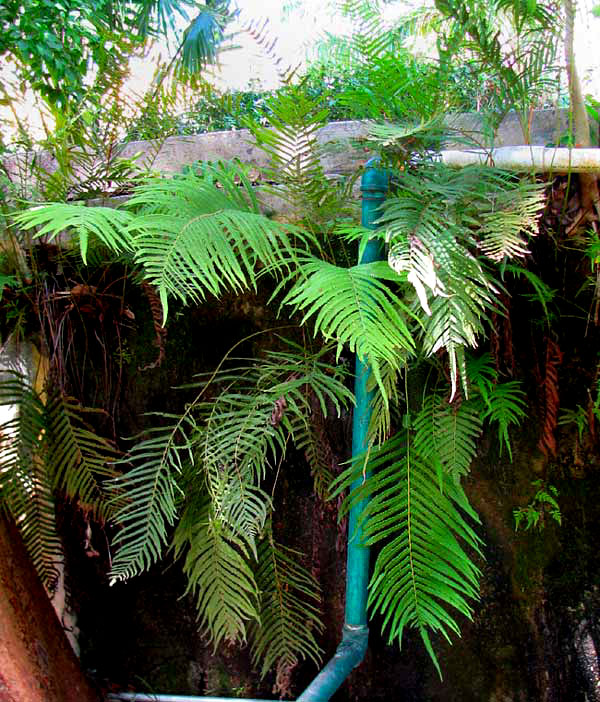
from the March 7, 2010 Newsletter issued from Hacienda Chichen Resort beside Chichén Itzá Ruins, central Yucatán, MÉXICO; limestone bedrock, elevation ~39m (~128ft), ~N20.676°, ~W88.569°
MAIDEN FERN ON THE CISTERN
So far at Hacienda Chichen I've found only a single population of Roughhairy Maiden Fern, THELYPTERIS HISPIDULA. It lives in dense shade on the mossy, water-saturated, limestone-rock walls of an old cistern supplying water to the gardens. You can see it above.
These are robust ferns with fronds averaging over three to four feet long (1-1.3 m). If you were with me this time last year in the woods near Natchez, Mississippi, you might remember our seeing the Southern Shield-Fern, Thelypteris kunthii, still shown at www.backyardnature.net/n/h/shield-f.htm.
These two species belong to the same genus, and are closely related within the genus. One of the most conspicuous features separating them is that our Roughhairy species is -- rough and hairy, as shown below:
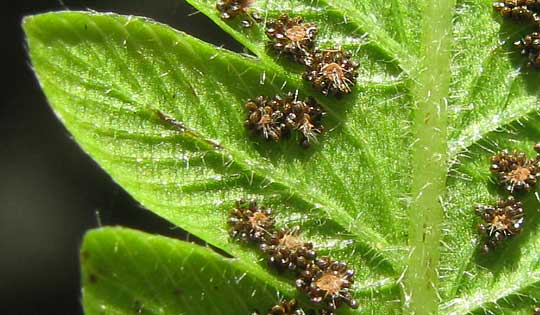
In that picture the dark, spherical items are the "fruit dots" or sori. Each sorus consists of many sporangia, which are the blackish, spherical little things in clusters in the picture. Inside each sporangium many spores are formed. Clearly, then, spores are very small. You can get an idea of how many spores must be produced from the fern's very many sporangia by looking at a small section of one frond below:
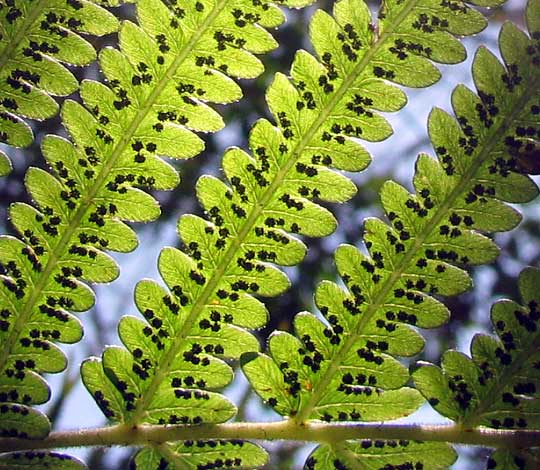
In the center of each sorus there's what looks like a more or less circular piece of brown paper. That's what remains of the indusium, which is the cellophane-like covering found on many sori. In the picture it looks like the indusia are attached at their centers, thus constitution the top part of an umbrella-shaped structure. Actually indusia in the genus Thelypteris are C-shaped, but often with the ends of the C almost touching, so that at first glance they can look like Os. Thelypteris's C-shaped indusia are attached to the frond along their sides. These seemingly unimportant details are very important to nail down when identifying ferns. You can see a Roughhairy Maiden Fern's frond with freshly developed indusia covering immature sori, better showing their C-shaped nature, below:
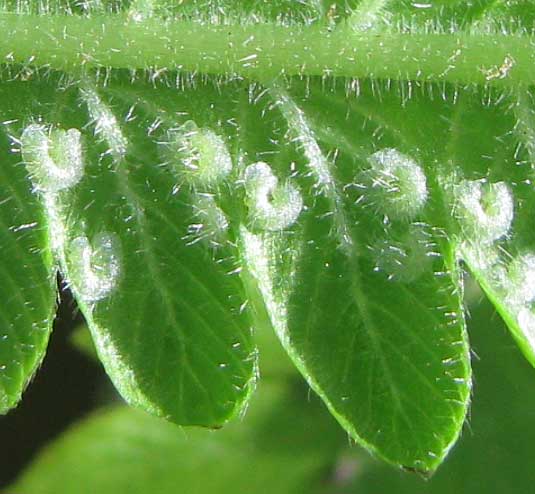
Roughhairy Maiden Ferns occur in the southeastern US, Mexico and the West Indies south through tropical South America, plus tropical Africa, Australia and southern Asia. The species is divided into four subspecies, and ours is not the same subspecies as in the US. One feature worth noting of our plants is that the fronds arise from exceptionally thick stems that creep along the cistern's mossy surface, as shown below:
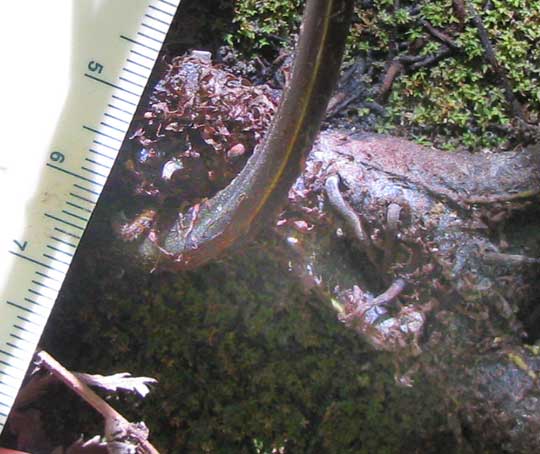
That stem is about 15 mm thick, over half an inch.
The Flora of North America describes its habitat as "Woodlands and limestone sinks, especially in seepage areas and along streams." That doesn't mention cistern walls, but with our cistern walls composed of cemented limestone rocks long saturated with water, I'd say that the fern must feel at home here, anyway.
from the March 4, 2012 Newsletter issued from Hacienda Chichen Resort beside Chichén Itzá Ruins; limestone bedrock; elevation ~39m (~128ft), N20.675°, W88.569°; central Yucatán state, MÉXICO
A FERN PROTHALLUS
As I walked past the Hacienda's water cistern I paused to nose in a patch of moss on the cistern's shady side. One thing I saw is shown below:
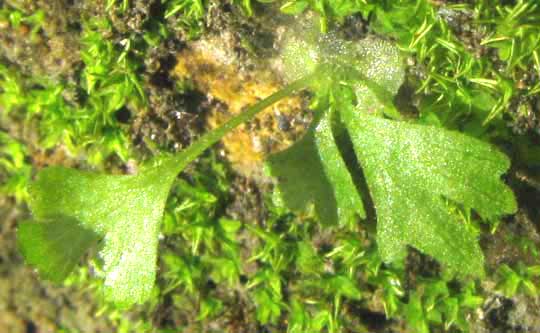
Here we're witnessing the "birth" of a Roughhairy Maiden Fern, THELYPTERIS HISPIDULA. What's interesting is that the reproduction of ALL ferns is not as simple as the fern frond producing spores, which then germinate to form new ferns. Fern reproduction is bizarre. It's almost as if human females should give birth not to human babies, but to dog pups. The dogs would then mate, but the female dog would give birth not to a baby dog, but to a baby human. And then the cycle would continue, human, dog, human, dog... Here's how it works in ferns:
When a fern spore germinates, what develops from the spore is not a fern frond, but rather a flat, more-or-less heart-shaped item about the size of a baby's thumbnail, known as a prothallus. A diagram of one is provided at ../fernprot.gif.
In that diagram, rhizoids are basically roots. The antheridia produce male sex germs, and the female sex germs reside in the archegonia. When male sperms swim through dew or rainwater to a receptive archegonium, fertilization takes place, and then the thing we think of as the fern -- the collection of fronds with their stems and roots -- sprouts from a fertilized archegonium. This sprout eventually matures and produces spores, and when the spores germinate, another prothallus is produced, and the cycle continues.
In our picture, the flat prothallus lies at the top of the picture. Two sprouting fronds emerge from an archegonium on the prothallus' underside, their stems passing between the prothallus' two lobes.